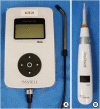Comparison of implant stability measurements between a resonance frequency analysis device and a modified damping capacity analysis device: an in vitro study
- PMID: 32128274
- PMCID: PMC7040444
- DOI: 10.5051/jpis.2020.50.1.56
Comparison of implant stability measurements between a resonance frequency analysis device and a modified damping capacity analysis device: an in vitro study
Abstract
Purpose: A stability-measuring device that utilizes damping capacity analysis (DCA) has recently been introduced in the field of dental implantology. This study aimed to evaluate the sensitivity and reliability of this device by measuring the implant stability of ex vivo samples in comparison with a resonance frequency analysis (RFA) device.
Methods: Six implant beds were prepared in porcine ribs using 3 different drilling protocols to simulate various implant stability conditions. Thirty-six pork ribs and 216 bone-level implants measuring 10 mm in height were used. The implant beds were prepared using 1 of the following 3 drilling protocols: 10-mm drilling depth with a 3.5-mm-diameter twist drill, 5-mm drilling depth with a 4.0-mm-diameter twist drill, and 10-mm drilling depth with a 4.0-mm-diameter twist drill. The first 108 implants were external-connection implants 4.0 mm in diameter, while the other 108 implants were internal-connection implants 4.3 mm in diameter. The peak insertion torque (PIT) during implant placement, the stability values obtained with DCA and RFA devices after implant placement, and the peak removal torque (PRT) during implant removal were measured.
Results: The intraclass correlation coefficients (ICCs) of the implant stability quotient (ISQ) results obtained using the RFA device at the medial, distal, ventral, and dorsal points were 0.997, 0.994, 0.994, and 0.998, respectively. The ICCs of the implant stability test (IST) results obtained using the DCA device at the corresponding locations were 0.972, 0.975, 0.974, and 0.976, respectively. Logarithmic relationships between PIT and IST, PIT and ISQ, PRT and IST, and PRT and ISQ were observed. The mean absolute difference between the ISQ and IST values on a Bland-Altman plot was -6.76 (-25.05 to 11.53, P<0.05).
Conclusions: Within the limits of ex vivo studies, measurements made using the RFA and DCA devices were found to be correlated under a variety of stability conditions.
Keywords: Dental implant; Diagnostic techniques and procedures; Osseointegration; Resonance frequency analysis.
Copyright © 2020. Korean Academy of Periodontology.
Conflict of interest statement
Conflict of Interest: No potential conflict of interest relevant to this article is reported.
Figures






Similar articles
-
Evaluation of primary stability of implants in bovine bone defects models.Sci Rep. 2025 Mar 25;15(1):10237. doi: 10.1038/s41598-025-95318-x. Sci Rep. 2025. PMID: 40133657 Free PMC article.
-
Effects of Drilling Protocol and Bone Density on the Stability of Implants According to Different Macrogeometries of the Implant Used: Results of an In Vitro Study.Int J Oral Maxillofac Implants. 2020 Sep/Oct;35(5):955-964. doi: 10.11607/jomi.8176. Int J Oral Maxillofac Implants. 2020. PMID: 32991646
-
A novel device for resonance frequency assessment of one-piece implants.Int J Oral Maxillofac Implants. 2012 May-Jun;27(3):523-7. Int J Oral Maxillofac Implants. 2012. PMID: 22616044
-
Influence of factors related to implant stability detected by wireless resonance frequency analysis device.J Oral Rehabil. 2010 Feb;37(2):131-7. doi: 10.1111/j.1365-2842.2009.02032.x. Epub 2009 Nov 30. J Oral Rehabil. 2010. PMID: 20002529
-
A Comparative Assessment of Primary Implant Stability Using Osseodensification vs. Conventional Drilling Methods: A Systematic Review.Cureus. 2023 Oct 11;15(10):e46841. doi: 10.7759/cureus.46841. eCollection 2023 Oct. Cureus. 2023. PMID: 37954787 Free PMC article. Review.
Cited by
-
Advancements in Methods of Classification and Measurement Used to Assess Tooth Mobility: A Narrative Review.J Clin Med. 2023 Dec 27;13(1):142. doi: 10.3390/jcm13010142. J Clin Med. 2023. PMID: 38202149 Free PMC article. Review.
-
Correlation of two different devices for the evaluation of primary implant stability depending on dental implant length and bone density: An in vitro study.PLoS One. 2024 May 22;19(5):e0290595. doi: 10.1371/journal.pone.0290595. eCollection 2024. PLoS One. 2024. PMID: 38776308 Free PMC article.
-
Comparison of 3D-Printed Dental Implants with Threaded Implants for Osseointegration: An Experimental Pilot Study.Materials (Basel). 2020 Oct 28;13(21):4815. doi: 10.3390/ma13214815. Materials (Basel). 2020. PMID: 33126589 Free PMC article.
-
Evaluation of primary stability of implants in bovine bone defects models.Sci Rep. 2025 Mar 25;15(1):10237. doi: 10.1038/s41598-025-95318-x. Sci Rep. 2025. PMID: 40133657 Free PMC article.
-
Comparison of primary and secondary stability of a one-piece compressive conometric implant system in the posterior upper and lower jaws.Front Oral Health. 2025 Jul 25;6:1625593. doi: 10.3389/froh.2025.1625593. eCollection 2025. Front Oral Health. 2025. PMID: 40786186 Free PMC article.
References
-
- Oh JS, Kim SG, Lim SC, Ong JL. A comparative study of two noninvasive techniques to evaluate implant stability: Periotest and Osstell Mentor. Oral Surg Oral Med Oral Pathol Oral Radiol Endod. 2009;107:513–518. - PubMed
-
- Zix J, Hug S, Kessler-Liechti G, Mericske-Stern R. Measurement of dental implant stability by resonance frequency analysis and damping capacity assessment: comparison of both techniques in a clinical trial. Int J Oral Maxillofac Implants. 2008;23:525–530. - PubMed
-
- Becker W, Hujoel P, Becker BE. Resonance frequency analysis: comparing two clinical instruments. Clin Implant Dent Relat Res. 2018;20:308–312. - PubMed
-
- Jaramillo R, Santos R, Lázaro P, Romero M, Rios-Santos JV, Bullón P, et al. Comparative analysis of 2 resonance frequency measurement devices: Osstell Mentor and Osstell ISQ. Implant Dent. 2014;23:351–356. - PubMed
-
- Lages FS, Douglas-de Oliveira DW, Costa FO. Relationship between implant stability measurements obtained by insertion torque and resonance frequency analysis: a systematic review. Clin Implant Dent Relat Res. 2018;20:26–33. - PubMed
LinkOut - more resources
Full Text Sources

